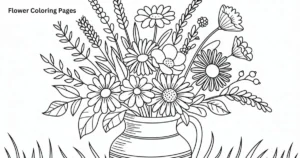Peonies are known for their breathtaking color transformations throughout the seasons. Their petals can soften, deepen, or fade due to factors like temperature, sunlight, and soil conditions. Some varieties start as vivid pinks or reds and gradually shift to pale blush, cream, or golden hues as they mature.
Understanding these seasonal color changes helps gardeners appreciate peonies at every stage. While cool spring air enhances rich tones, summer heat often causes gentle fading. With proper care, adequate sunlight, deep watering, and nutrient-rich soil, peonies can maintain their brilliance, ensuring a stunning floral display year after year.
Read More: What Colors Do Peonies Fade Into By Seasons?
Understanding Peony Color Evolution
Genetics, environmental conditions, and aging blooms influence peony color evolution. Some varieties naturally shift shades due to pigment breakdown, while temperature and sunlight further alter hues. Cooler climates deepen colors, while heat causes fading. Over time, vibrant peonies gradually transform into softer pastels or muted tones, completing their natural cycle.
Role of Genetics in Peony Color Shifts
Peonies inherit their color-changing abilities from their genetics. Some varieties, like ‘Coral Charm’, start as a deep coral and fade to pale peach or cream. Pigments like anthocyanins and carotenoids control these shifts, making some peonies more prone to dramatic transformations.
Environmental Impacts on Petal Pigmentation
External conditions also shape petal colors. Cool spring weather enhances deep reds and purples, while hot summers cause softening into pastels. Soil pH can influence white and yellow peonies, sometimes making them appear more vibrant or muted depending on mineral absorption.
Spring Bloom: Vibrant Beginnings
Spring marks the most vibrant phase for peonies, with blooms emerging in rich pinks, deep reds, and bright yellows. Cooler temperatures enhance petal saturation, while fresh buds display intense hues. As the season progresses, some peonies gradually soften into pastel or lighter shades.
Common Colors of Peonies During Early Bloom
Spring peonies emerge in rich pinks, deep reds, and bright yellows. At this stage, petals are at their freshest and most saturated. Some white peonies may have a soft blush when they first open, which fades as the bloom expands.
Influence of Temperature and Soil Conditions
Springtime temperatures affect the depth of color in peonies. Cooler climates enhance pigmentation, making reds look deeper and whites appear crisp. Well-balanced soil with high organic matter supports vibrant hues, while poor soil can lead to dull or washed-out blooms.
Summer Changes: Softening and Fading
During summer, peony petals soften and fade as intense sunlight breaks down pigments. Vibrant pinks turn pastel, deep reds become dusty rose, and whites may develop a yellowish hue. Heat stress accelerates fading, making blooms appear lighter and more delicate as the season progresses.
How Sunlight and Heat Affect Petal Colors
As temperatures rise, peony petals fade into softer shades. Strong sunlight can break down pigments, turning bright pinks into pale blush and deep reds into dusty rose tones. White peonies may become translucent or develop a yellowish hue due to sun exposure.
Examples of Peonies That Lighten in Summer
Certain peonies undergo dramatic summer fading. ‘Coral Sunset’ starts as a bright coral and fades into apricot, while ‘Bowl of Cream’ maintains its ivory shade but softens in intensity. Tree peonies, especially lighter varieties, may also lose vibrancy under intense heat.
Autumn Transformations: Deepening Hues
As autumn arrives, cooler temperatures can intensify peony hues, especially in red and purple varieties. Some peonies regain richer, deeper tones, while others fade into muted shades before dormancy. Tree peonies often display stronger autumn colors, while herbaceous types gradually lose vibrancy before wilting.
Do Peonies Develop Richer Colors in Fall?
Some peonies display a reverse effect in autumn, where cooler nights restore or darken colors. This is more common in red and purple varieties, which may regain richness due to temperature drops. However, most peonies stop blooming by early fall.
Late-Season Fading vs. Intensified Pigmentation
While some peonies revive their colors, others experience final-stage fading. The last blooms often appear dustier or muted, signaling the end of their cycle. Tree peonies tend to develop deeper autumn hues, while herbaceous peonies mostly fade before dormancy.
Winter Dormancy: The Resting Phase
During winter dormancy, peonies shed their petals and turn dormant, conserving energy for the next bloom cycle. Their stems wither, and foliage yellows before dying back completely. Cold temperatures strengthen their roots, ensuring a healthier, more vibrant bloom when spring arrives. Proper winter care is essential.
How Peonies Lose Their Color Before Dormancy
As winter approaches, peony petals wither and drop, leaving behind only bare stems and yellowing foliage. The plant redirects energy to its roots, preparing for the next bloom cycle. Any remaining petals turn brown and crisp before falling away.
Impact of Seasonal Cycles on Next Year’s Bloom
Peonies need a cold dormancy period to bloom again in spring. The winter cold strengthens the plant, ensuring a vibrant return. Without this rest phase, peonies may bloom less vigorously or produce weaker colors in the next cycle.
Peony Varieties with Dramatic Color Changes
Some peony varieties undergo stunning color transformations as they bloom. ‘Coral Charm’ shifts from deep coral to soft peach, while ‘Bartzella’ fades from bright yellow to pale gold. Tree peonies often darken in cooler weather, creating a spectacular seasonal display of evolving hues.
Tree Peonies vs. Herbaceous Peonies
Tree peonies often display stronger color shifts compared to herbaceous types. They can start with bold hues like red or purple and transform into silvery pastels or golden yellows. Herbaceous peonies tend to fade rather than change colors drastically.
Notable Varieties That Change Color Dramatically
Several peonies are famous for their color transitions:
- ‘Coral Charm’: Changes from coral to peach and cream.
- ‘Festiva Maxima’: Starts pure white but develops pink flecks.
- ‘Bartzella’: A yellow Itoh peony that fades into pale gold.
Care Tips to Preserve Peony Colors
To preserve peony colors, plant them in morning sunlight while avoiding harsh afternoon heat. Water deeply once a week, ensuring moist but well-drained soil. Mulch around roots to retain moisture and protect pigments. Deadhead spent blooms to promote fresh, vibrant flowers throughout the season.
How to Maintain Bright and Lasting Colors
To keep peony colors rich, plant them in partial sunlight rather than full exposure. Excessive heat speeds up fading, so mulching and watering deeply can help maintain color vibrancy. Deadheading spent blooms also encourages fresher, brighter flowers.
Watering, Sunlight, and Soil Recommendations
- Water peonies deeply once a week to prevent stress-related fading.
- Provide morning sun but avoid the harsh afternoon heat.
- Use nutrient-rich, well-draining soil to support strong pigmentation.
Conclusion
Peonies undergo stunning color transformations throughout the seasons, from vibrant spring blooms to soft summer fades and autumn deepening hues. Their changes are influenced by genetics, temperature, and soil conditions, making each variety unique. Proper care, including adequate sunlight, deep watering, and nutrient-rich soil, helps maintain their rich pigmentation for longer.
Understanding these seasonal shifts allows gardeners to appreciate peonies at every stage, ensuring they thrive year after year. By selecting color-changing varieties and following essential care tips, you can enjoy a spectacular peony display with lasting beauty throughout the growing season.
FAQs
Why do peonies change color as they age?
Peonies fade due to sunlight, temperature shifts, and natural petal aging.
Which peony varieties have the most dramatic color changes?
Varieties like ‘Coral Charm,’ ‘Bowl of Beauty,’ and ‘Bartzella’ show significant shifts.
Does soil type affect peony color?
Yes, nutrient-rich and well-balanced soil helps maintain vibrant petal hues.
Can cooler temperatures intensify peony colors?
Yes, cooler weather deepens reds and purples, while heat softens shades.
How can I prevent peonies from fading too quickly?
Plant in the morning sun, water regularly, and mulch to protect color vibrancy.









